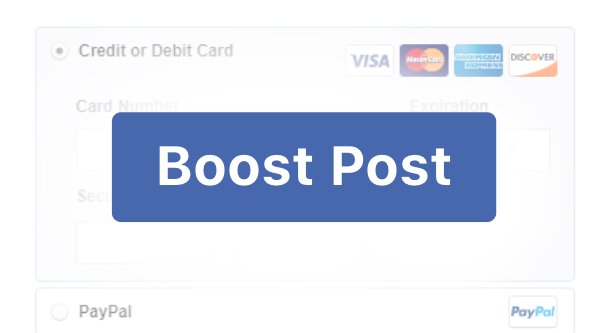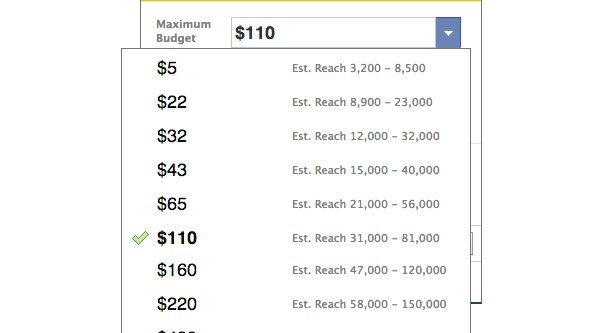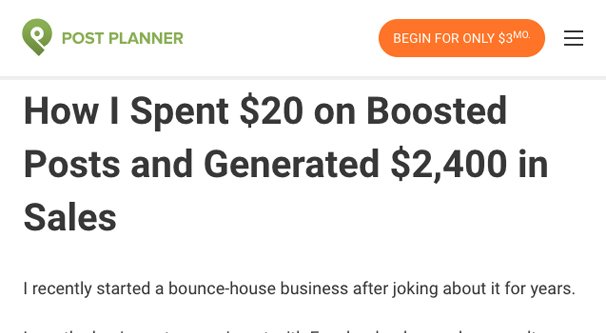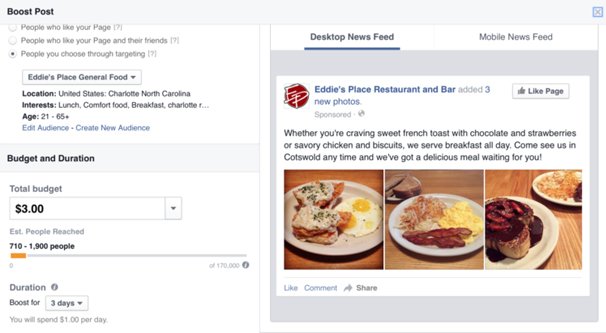How Much Should You Spend on Facebook’s “Boost Post”?

In the past, I have been fairly adamant about not using the Boost Post button in Facebook. That’s because, in the past, many people have used it solely as a one-click way to lose money.
The Boost Post button converts an organic post into an ad, allowing you some ad targeting, but it’s nowhere near as variable or as robust as creating an ad from scratch. That said, it’s better than it used to be, and it’s worth using if you don’t have the time, inclination, or budget to dig deeper in to advertising.
Think of it this way. Boosting a post is better than doing nothing, and full ads management is better than just boosting a post. More than that, running ads with Power Editor is even better, and hiring a full-time ads manager with a proportionate budget is the best of all.
Still, we’re not talking about running detailed ads today. We’re just talking about boosting posts. So, if you’re interested in getting your ad feet wet, where should you start? What’s a good budget?
Why Boosting Posts is a Good Idea
You can get a lot of benefit out of boosting posts, even if it’s a less efficient means to getting those benefits. I fully understand that not everyone has six hours a day to dig into ads management.
Boosting posts is a good way to make up for the constant depression Facebook has put on posts. Year over year, we always see stories about the decline of organic reach, and how every change Facebook makes is the change that finally kills the site for businesses. As of yet, it hasn’t died, but plenty of folks have dialed back on spending or stopped entirely. The latest change is Facebook’s friends and family priority visibility, and it’s only going to get worse.
You can counteract lower reach numbers in a lot of ways, but by far the simplest way is to just pay for more exposure. Sure, that’s what Facebook wants, and there’s an argument to be made that you shouldn’t give in to Facebook’s demands and reward them for punishing you, but it’s not the end of the world.
Another benefit is the ability to reach an audience beyond the people who already follow you. Normally you reach, what, 5% of the people who follow you, and a small number of the friends of those people when those people share the post? When you boost a post, you get additional exposure amongst a targeted audience you choose, regardless of whether those people follow you or are interested in doing so. Obviously, you want to target people who are likely to follow you, but you don’t have to. One of Jon Loomer’s favorite strategies is to target your own audience just to boost reach and engagement from your existing audience, which can carry over to other posts for quite a while.
Boosting a post also gives you the ability to access more detailed post analytics for that post, since it’s now an ad. Facebook already gives pages some pretty detailed information, but this knocks it out of the park.
And, of course, boosting a post is simply an easy way to convert money into eyes on page. It’s not the most effective or the most efficient for the cost, but it’s definitely not something to ignore entirely.
Factors Affecting Cost
I can’t tell you a specific cost for boosting a post, because the cost changes depending on a number of variables. The number I give you based on my own Facebook pages would be different than the number you get.
First up, you have to consider the type of post you want to boost. Some types of posts require more to get going than others. A basic text post might not be very engaging, while a photo might have better returns, and a video even better.
The audience you choose to target has a big effect as well. The more targeted the audience, the more interested in your content the audience is likely to be, the cheaper your ads are going to be. Or, rather, the cost might not decrease, but the returns will increase, so it works out the same.
And, of course, the duration of your campaign. You can boost a post for just a few hours, a few days, or weeks on end. Every post has diminishing returns and audience saturation points, so you need to be aware of how long your posts are bringing in returns.
The sheer cost of boosting a post is not usually the issue, though. Generally, if you’re boosting a post, you want that post to be something that gets you tangible returns. No one is going to boost a post that shows what they had for lunch that day, unless they’re a food blogger or restaurant critic. No, you want your boosted posts to be something with mailing list signups, product purchases, or opt-ins somehow involved. You want tangible returns, so you can measure how well your posts perform.
In these cases, you might be spending X amount of money on your posts, but it doesn’t really matter. You’re making X+1 from the posts as long as they’re boosted. Profits are profits, so long as you’re not losing money, you’re doing well.
Budget Selection
Facebook’s boost post option allows you to set pretty much any budget you want to, so long as it’s at least $1 per day. So the absolute minimum you can spend if you want to boost a post is $1, and that will boost your post for one day, more or less. The actual duration of the exposure is more likely to rely on the metrics coming in from the post than the time duration, but that’s the minimum Facebook allows you to spend.
A month-long campaign of boosting posts is going to cost you around $30 minimum, then, and will get you however much in return you manage to get based on the quality of your post and your target audience.
When you go to boost a post, you can choose your audience, and Facebook will provide you with an estimate for how much it will cost to reach that audience. Different amounts of money will, of course, reach different numbers of people. For example, $1 might reach 80-100 people on the low end, or as many as 400 people if you’re really lucky. $5 could reach 400 minimum or up to 2,000 on a good day.
Every audience targeting factor will change the estimated cost, some up and some down. Some target audiences are in higher demand than others. Competition can be a big factor, so even the time of the year can adjust costs. It will cost more to reach people when boosting a post closer to the holiday season, because more people are ramping up their ad spend to reach as many people as they can.
If you want an example of some concrete data, Scott Ayres over at PostPlanner published a case study about a time where he spent $20 boosting posts and ended up making $2,400 in sales because of it. That $20 brought him in 4,600 people in reach, 22 new followers, and 71 reactions on the post.
Granted, this information is almost four years old at this point, so it’s not necessarily accurate to the results you’ll get today. He had a single high value product he was selling and the post was directly selling that product, as well.
There’s also the fact that his particular business in this example doesn’t necessarily scale very well. He has a limited availability for the single product he’s selling. He can’t, say, double his spend and also double his profits. Maybe it was a fluke, maybe it wasn’t. Only experimentation can tell.
How to Boost a Post Effectively
If you’ve been sold, or at least have enough extra budget to boost a few posts and see how they perform, here’s how you can do it.
The first thing you need to do is, well, have an established presence. You want to have a Facebook page that’s all set up and populated with content. It’s going to be harder to boost a post effectively from a brand new page.
You also have to decide on a post you want to boost. As I mentioned above, you generally want to choose a post that is focused on a product or service, something tangible that you can measure results from.
If you want to get something like new page likes, email newsletter subscribers, or something else that doesn’t have a dollar sign attached, you’re going to need to keep track of your data and see how it compares to other sources of those metrics. If you spend $20 and get 100 subscribers, that’s great, but if you get 90 subscribers from an organic posts you didn’t pay for, you’re really paying $20 for 10 subscribers. You need to know what you’re getting and you need to be able to assign a value to it. Obviously, it’s easier if you’re just selling a product and can track how many people buy it because of the post.
To this end, it can also be beneficial to have the Facebook Tracking Pixel installed on your site, in your conversion funnel. Boosting a post won’t necessarily give you detailed tracking using that conversion funnel, but it will show up in your analytics, so you can track the data yourself. It’s quite easy to install the tracking pixel on pretty much any site, too, so you might as well implement it as part of your foundation moving forward.
Once you have drafted up the post you want, make sure it has the right landing page or link, the right information or call to action, and is free of typos. You don’t want to spend to put a mistake in front of more people, right?
You have two ways to boost a post now. You can post the content organically, and then click the “boost post” button under it once it’s live. Or you can choose the “boost post” option when you’re choosing what type of post you’re posting. This will allow you to boost the post from the word go, instead of having that slight delay.
In either case, you will be taken to the boost post menu, where you can choose your targeting options. Now, you can read extended articles about all the Facebook ad targeting options, but you don’t get access to those targeting options through the boost post box. You have to actually go into the ads manager and make an ad to use them.
With boosted posts, you get to choose locations, age ranges, whether or not the audience likes your page, and if you want to reach friends of followers as well. You have interest targeting as well, but you don’t have many of the advanced options, like education level, income level, and so on.
As you define the audience you want to reach, Facebook will give you a very basic scale of how well define the audience is. Too broad an audience and you’ll be wasting money. Too narrow an audience and you’ll be wasting reach. Of course, when Facebook tells you your potential reach is 7 million people or whatever, that only applies if you have the budget to reach them. You won’t be reaching 7 million people with $20.
If you’re new to boosting posts, I recommend starting small. $1 a day is enough to spend to get you some reasonable results, probably in the mid-hundreds to a few thousand people reached in a given period. If you like the results, you can bump up your budget. If you don’t like them, you can cancel the boost midway through a week or month and try again with a different post later.
You will also be asked to choose a duration for your boost to run. You can choose a day, a week, two weeks, or a date in the future where you want the boost to stop. The duration will be limited by your budget. Say you have a budget of $10. If you set duration to be 1 day, you spend $10 in one day. If you set the duration to be 1 week, you will spend a bit over $1 per day for 7 days. You won’t be able to choose 14 days, because you will have to increase your budget to at least $14.
Once everything is set, you can preview your post and make sure it all looks good. Facebook will then ask for a payment option if you don’t have one on file, which will generally mean a credit card. Add your payment information and confirm it, and Facebook will set your newborn ad free.










